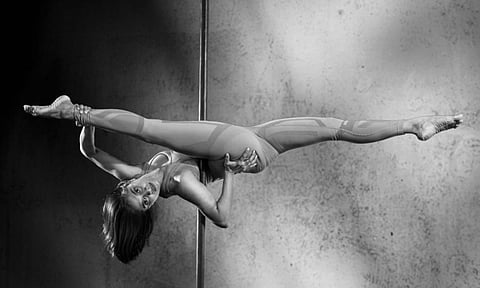

CHENNAI: Women in Chennai have for decades gracefully owned their skills of classical dance forms – from temple courtyards to the hallowed halls of sabhas. But there are many other women, who are moulding their bodies into skilful poetry – not in the ink of traditions, but with impressions of a movement. In studios across the city, the whispers of spinning poles and staccato click of stilettos weave new verses of freedom.
Women, in almost every sphere of life, have often been subjected to questions oppressed upon the stark reality of how they ‘must’ portray themselves. It even includes artistic expressions. However, women in the city, through the means of dance, and with a rebellious pulse to life, are transforming the norm from ‘how a woman should move’, to ‘how a woman chooses to move’.
Defying gravity, spinning new narrative
At the serene space of The Pole Camp, a pole dancing studio owned by Anusha Swamy, a grandmother clutches her saree pallu watching her granddaughter twirl upside down a chrome pole.
Being a former Kuchipudi dancer who stumbled upon pole dancing almost by accident during a holiday in Melbourne, her studio has challenged perceptions and empowered women in a conservative landscape.
Pole dancing is often conflated with titillation. But Anusha is redefining it as an art form as well as a demanding sport. “It’s not just about spinning on a pole. They learn strength, flexibility, mobility, and choreography.”
But the physical and financial investment is significant – poles cost Rs 70,000–80,000, and classes run upwards of Rs 1,000 per session. Yet, they have adverse clientele – from a six-year-old to even septuagenarians, and women of all body types. The biggest misconception? “That you need to be light or ultra-fit. But there are styles for everyone.”
When Anusha opened her studio in 2021, skepticism did linger. Pole dancing is often associated with item numbers in Indian cinema. But social media and word-of-mouth have managed to shift narratives.
At 45, Dr Aarthi L, a dermatologist is rewriting rules for women in conservative spaces by spinning effortlessly on a pole. “Pole fitness didn’t just change my body; it changed my life. Every inverted spin, every grip-defying hold became a metaphor for overcoming obstacles. When I master a difficult move, it’s not just a physical win, rather proof that age and society’s expectations are just illusions.”
Aarthi’s Instagram posts showcasing her progress certainly did more than just documenting her journey. They ignited curiosity in women across the city who also went on to join. “I have also enrolled both my daughters. Why should society decide what art forms women can embrace? Strength and expression aren’t age-gated.”
So far, Anusha has trained over 700 students across Chennai. She believes that Chennai could become the country’s pole capital. “Like surfing, pole dancing too could pick up traction in the city.” As the conversation turns to sensuality in dance, Anusha is unequivocal, “Women shouldn’t be sexualised for expressing themselves. Dance is about emotion. Like Bharatanatyam’s navarasa, pole expresses nine emotions – sensuality being just one.”
Reclaiming sexuality
In a Chennai studio, stilettos click to a radical rhythm as Shweta Painthamizh, 24, is leading a heels dance class that’s rewriting cultural standards.
Born in Chennai but raised in California, she was rejected from classical dance as a child due to her caste, which prevails even in the west (among Indian diaspora).
This made Shweta to take a plunge in ballet, jazz, and later, hip-hop. It was in the Black American dance community that she discovered movement as a language of resistance. “Hip-hop wasn’t just about the steps. It was about reclaiming space, about telling stories that the mainstream ignored.”
Years later, when she returned to Chennai in 2020, she brought that ethos with her, along with a pair of stilettos.
She dismantles the notion that heels dancing is a western form, with no roots in Indian culture. “Heels are just footwear. What we’re doing with them is as Indian as it gets.”
Shweta draws connections to the Devadasis, the temple dancers who once practiced Sadir, the precursor to Bharatanatyam, before it was sanitised and appropriated by upper-caste custodians. She speaks of Therukoothu, the Tamil folk theatre where exaggerated, expressive movements carried coded rebellions. “Even the cinematic item number is a distorted echo of what feminine power in motion can look like – when it’s not filtered through the male gaze.”
Queer and trans students began showing up to her classes, finding in her studio, one of the few spaces where they could move without judgment.
“Bahujan women, long conditioned to see their bodies as something to be modestly contained, discovered a new language of autonomy. A mother, after attending my workshop with her teenage daughter, pulled me aside and told me how her daughter learned more about consent in that one class than in years of school.”
Shweta dreams of heels dancing as a feminist pedagogical tool, integrated into gender studies programs. She wants to use movement to challenge caste hierarchies in the arts. She also imagines collaborations that bridge folk traditions and contemporary resistance, creating a living, evolving dialogue.